The SwissHydro research program investigates three different aspects of the prospect of hydropower in Switzerland: system integration, future electricity market prices in Europe, and optimal dispatch with decision-making under uncertainty.
The first aspect considers the optimal integration of hydropower into the future Swiss energy system, in which the flexibility of hydropower and its near-zero carbon emissions can contribute to system stability and to a low carbon economy. A special focus is the hourly flexible storage capacity for intermittent renewables, and the synergy with the heat sector. For this part, we use a long-term energy-system model, which extends the Swiss TIMES energy system model (STEM). Apart from such system aspects, the profitability of hydropower plants depends on the future electricity prices on the integrated European markets. Hence, in the second part of the project, we use a Nash-Cournot equilibrium model to investigate the market behavior of players under different future investment decisions and energy policy scenarios. This model yields (aggregated) electricity prices. In the third part of the project, we investigate the profitability of an optimal dispatch of hydropower against exogenous stochastic prices and stochastic natural water inflow; the price levels are given by the previous market model. In particular, we investigate pumped-hydropower. We use multistage stochastic programming on a scenario tree, and we assume risk-averse decision making. |

